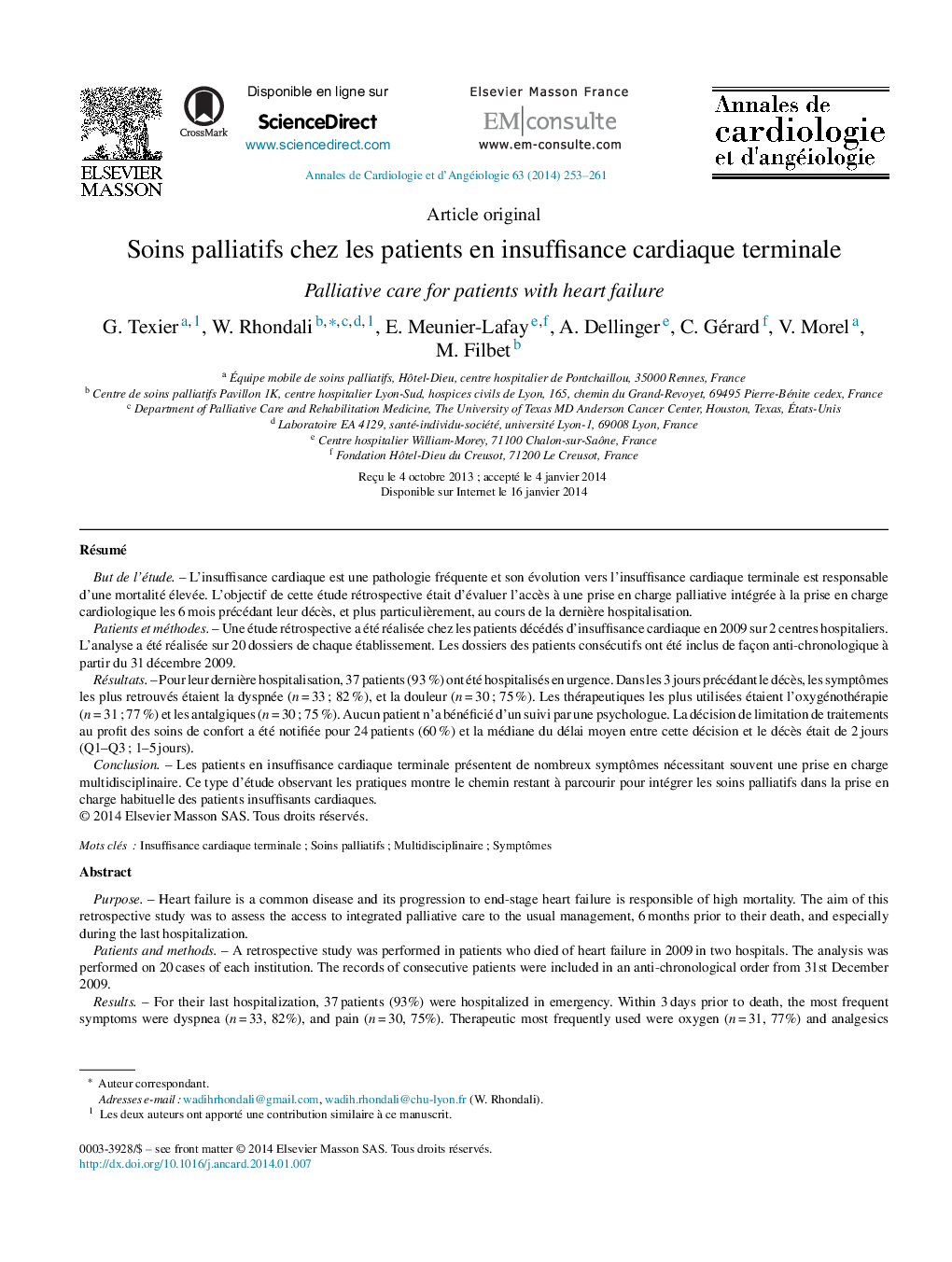| Article ID | Journal | Published Year | Pages | File Type |
|---|---|---|---|---|
| 2868740 | Annales de Cardiologie et d'Angéiologie | 2014 | 9 Pages |
RésuméBut de l’étudeL’insuffisance cardiaque est une pathologie fréquente et son évolution vers l’insuffisance cardiaque terminale est responsable d’une mortalité élevée. L’objectif de cette étude rétrospective était d’évaluer l’accès à une prise en charge palliative intégrée à la prise en charge cardiologique les 6 mois précédant leur décès, et plus particulièrement, au cours de la dernière hospitalisation.Patients et méthodesUne étude rétrospective a été réalisée chez les patients décédés d’insuffisance cardiaque en 2009 sur 2 centres hospitaliers. L’analyse a été réalisée sur 20 dossiers de chaque établissement. Les dossiers des patients consécutifs ont été inclus de façon anti-chronologique à partir du 31 décembre 2009.RésultatsPour leur dernière hospitalisation, 37 patients (93 %) ont été hospitalisés en urgence. Dans les 3 jours précédant le décès, les symptômes les plus retrouvés étaient la dyspnée (n = 33 ; 82 %), et la douleur (n = 30 ; 75 %). Les thérapeutiques les plus utilisées étaient l’oxygénothérapie (n = 31 ; 77 %) et les antalgiques (n = 30 ; 75 %). Aucun patient n’a bénéficié d’un suivi par une psychologue. La décision de limitation de traitements au profit des soins de confort a été notifiée pour 24 patients (60 %) et la médiane du délai moyen entre cette décision et le décès était de 2 jours (Q1–Q3 ; 1–5 jours).ConclusionLes patients en insuffisance cardiaque terminale présentent de nombreux symptômes nécessitant souvent une prise en charge multidisciplinaire. Ce type d’étude observant les pratiques montre le chemin restant à parcourir pour intégrer les soins palliatifs dans la prise en charge habituelle des patients insuffisants cardiaques.
PurposeHeart failure is a common disease and its progression to end-stage heart failure is responsible of high mortality. The aim of this retrospective study was to assess the access to integrated palliative care to the usual management, 6 months prior to their death, and especially during the last hospitalization.Patients and methodsA retrospective study was performed in patients who died of heart failure in 2009 in two hospitals. The analysis was performed on 20 cases of each institution. The records of consecutive patients were included in an anti-chronological order from 31st December 2009.ResultsFor their last hospitalization, 37 patients (93%) were hospitalized in emergency. Within 3 days prior to death, the most frequent symptoms were dyspnea (n = 33, 82%), and pain (n = 30, 75%). Therapeutic most frequently used were oxygen (n = 31, 77%) and analgesics (n = 30, 75%). No patient was seen by a psychologist. The decision to limit treatment for comfort care was reported for 24 patients (60%) and the median of the average time between the decision and death was 2 days (Q1–Q3, 1–5 days).ConclusionPatients with terminal heart failure have many symptoms often requiring multidisciplinary care. This type of study relating practices shows that there is still a lot to do to integrate palliative care in the usual management of patients with heart failure.
